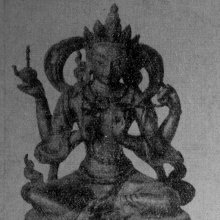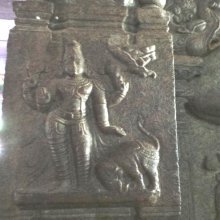Bowing: 1 definition
Introduction:
Bowing means something in Hinduism, Sanskrit. If you want to know the exact meaning, history, etymology or English translation of this term then check out the descriptions on this page. Add your comment or reference to a book if you want to contribute to this summary article.
Images (photo gallery)
In Hinduism
Natyashastra (theatrics and dramaturgy)
Source: Shodhganga: Elements of Art and Architecture in the Trtiyakhanda of the Visnudharmottarapurana (natya)Bowing is associated with Khaṭakāvardhamāna-hasta: one of the thirteen Combined-hand Gestures (in Indian Dramas) (known as saṃyuktahastas), according to the Viṣṇudharmottarapurāṇa, an ancient Sanskrit text which (being encyclopedic in nature) deals with a variety of cultural topics such as arts, architecture, music, grammar and astronomy.—The word khaṭakāvardhamāna is an amalgamation of two words viz., khaṭaka and vardhamāna. The word khaṭaka denotes a half closed hand and vardhamāna means increasing. In khaṭakāvardhamāna posture both of the hands are in khaṭaka position and one hand is placed upon another. This hand posture is used in love making and bowing.

Natyashastra (नाट्यशास्त्र, nāṭyaśāstra) refers to both the ancient Indian tradition (shastra) of performing arts, (natya—theatrics, drama, dance, music), as well as the name of a Sanskrit work dealing with these subjects. It also teaches the rules for composing Dramatic plays (nataka), construction and performance of Theater, and Poetic works (kavya).
See also (Relevant definitions)
Full-text (+361): Vinati, Namana, Avanati, Nati, Vinamana, Padapranama, Prahvana, Pranati, Avanatashirshan, Kritanati, Pranama, Anati, Avanama, Prahvanjali, Sannati, Anamra, Namas, Pranamin, Namratva, Avanamin.
Relevant text
Search found 141 books and stories containing Bowing; (plurals include: Bowings). You can also click to the full overview containing English textual excerpts. Below are direct links for the most relevant articles:
Garga Samhita (English) (by Danavir Goswami)
Verse 1.3.34 < [Chapter 3 - Description of the Lord’s Appearance]
Verse 5.18.24 < [Chapter 18 - Uddhava Hears the Gopīs’ Words and Returns to Mathurā]
Verse 1.16.39 < [Chapter 16 - Description of Śrī Rādhikā’s Wedding]
Sahitya-kaumudi by Baladeva Vidyabhushana (by Gaurapada Dāsa)
Text 11.32 < [Chapter 11 - Additional Ornaments]
Text 7.63 < [Chapter 7 - Literary Faults]
Text 7.18 < [Chapter 7 - Literary Faults]
The Brahma Purana (by G. P. Bhatt)
Chapter 54 - Visit to Kṛṣṇa Shrine
Chapter 55 - The Greatness of Narasiṃha
Buddhist records of the Western world (Xuanzang) (by Samuel Beal)
Chapter 14 - Forms of Politeness used in India < [Book II - Three Countries]
Chapter 34 - Country of Kia-pi-shi (Kapiśa or Kapisha) < [Book I - Thirty-Four Countries]
Chapter 1 - Country of Mo-kie-t’o (Magadha), part 1 < [Book VIII and IX]
Ecstasy and Agony < [July – September, 2003]
Home-Thoughts from Abroad < [July 1950]
Book Reviews < [October – December, 1997]


